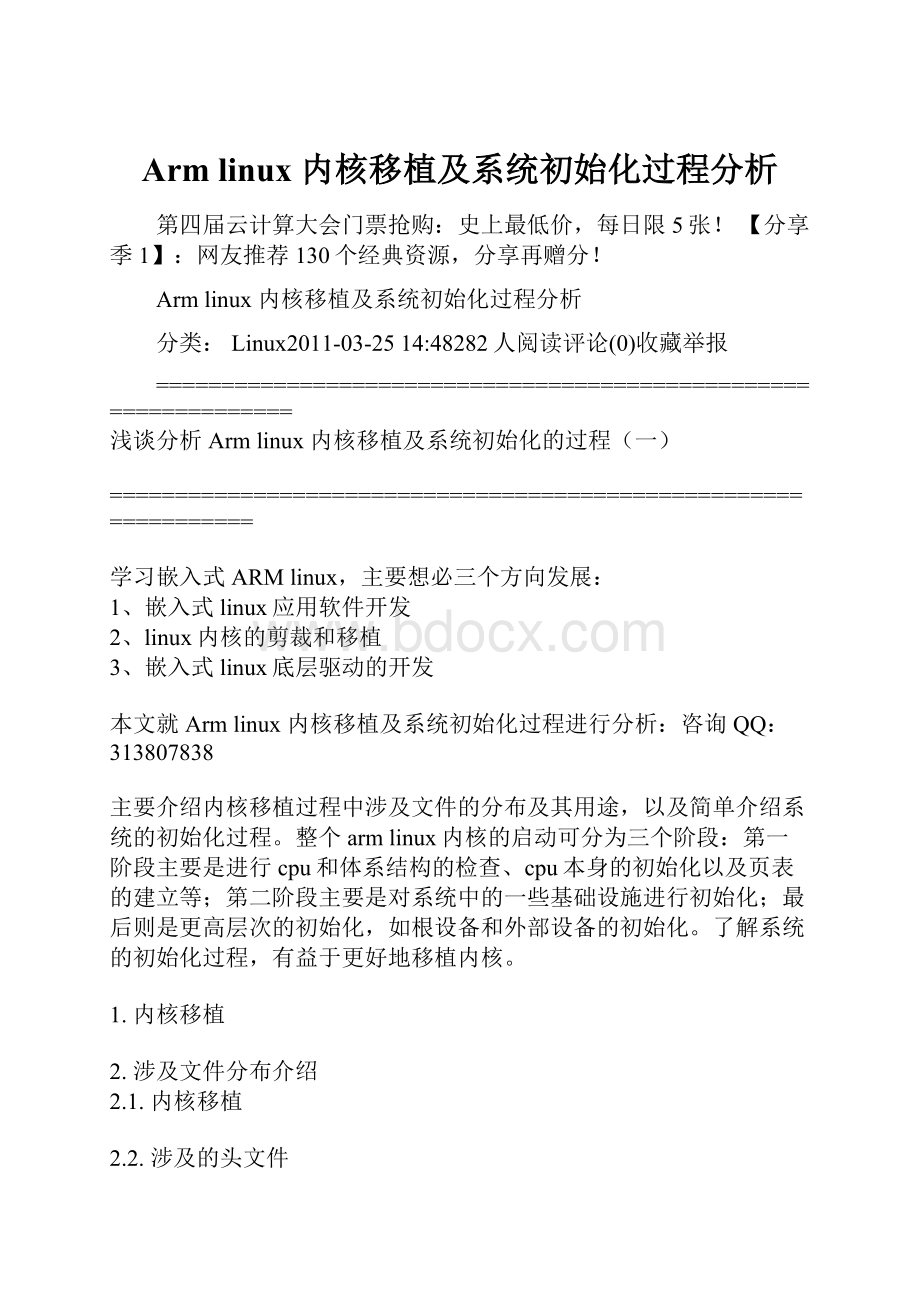Arm linux 内核移植及系统初始化过程分析.docx
《Arm linux 内核移植及系统初始化过程分析.docx》由会员分享,可在线阅读,更多相关《Arm linux 内核移植及系统初始化过程分析.docx(26页珍藏版)》请在冰豆网上搜索。

Armlinux内核移植及系统初始化过程分析
第四届云计算大会门票抢购:
史上最低价,每日限5张!
【分享季1】:
网友推荐130个经典资源,分享再赠分!
Armlinux内核移植及系统初始化过程分析
分类:
Linux2011-03-2514:
48282人阅读评论(0)收藏举报
================================================================
浅谈分析Armlinux内核移植及系统初始化的过程
(一)
================================================================
学习嵌入式ARMlinux,主要想必三个方向发展:
1、嵌入式linux应用软件开发
2、linux内核的剪裁和移植
3、嵌入式linux底层驱动的开发
本文就Armlinux内核移植及系统初始化过程进行分析:
咨询QQ:
313807838
主要介绍内核移植过程中涉及文件的分布及其用途,以及简单介绍系统的初始化过程。
整个armlinux内核的启动可分为三个阶段:
第一阶段主要是进行cpu和体系结构的检查、cpu本身的初始化以及页表的建立等;第二阶段主要是对系统中的一些基础设施进行初始化;最后则是更高层次的初始化,如根设备和外部设备的初始化。
了解系统的初始化过程,有益于更好地移植内核。
1.内核移植
2.涉及文件分布介绍
2.1.内核移植
2.2.涉及的头文件
/linux-2.6.18.8/include
[root@localhostinclude]#tree-L1
.
|--Kbuild
|--acpi
|--asm->asm-arm
|--asm-alpha
|--asm-arm------------------------------->
(1)
|--asm-sparc
|--asm-sparc64
|--config
|--keys
|--linux------------------------------->
(2)
|--math-emu
|--media
|--mtd
|--net
|--pcmcia
|--rdma
|--rxrpc
|--scsi
|--sound
`--video
内核移植过程中涉及到的头文件包括处理器相关的头文件
(1)和处理器无关的头文件
(2)。
2.3.内核移植2.4.涉及的源文件
/linux-2.6.18.8/arch/arm
[root@localhostarm]#tree-L1
.
|--Kconfig
|--Kconfig-nommu
|--Kconfig.debug
|--Makefile
|--boot------------------------------->
(2)
|--common
|--configs
|--kernel------------------------------->(3)
|--lib
|--mach-at91rm9200
……
|--mach-omap1
|--mach-omap2
|--mach-realview
|--mach-rpc
|--mach-s3c2410------------------------------->(4)
|--mach-sa1100
|--mach-versatile
|--mm------------------------------->(5)
|--nwfpe
|--oprofile
|--plat-omap
|--tools------------------------------->
(1)
`--vfp
(1)
/linux-2.6.18.8/arch/arm/tools
[root@localhosttools]#tree-L1
.
|--Makefile
|--gen-mach-types
`--mach-types
Mach-types文件定义了不同系统平台的系统平台号。
移植linux内核到新的平台上需要对新的平台登记系统平台号。
Mach-types文件格式如下:
#machine_is_xxxCONFIG_xxxxMACH_TYPE_xxxnumber
s3c2410ARCH_S3C2410S3C2410182
smdk2410ARCH_SMDK2410SMDK2410193
之所以需要这些信息,是因为脚本文件linux/arch/arm/tools/gen-mach-types需要linux/arch/tools/mach-types来产生linux/include/asm-arm/mach-types.h文件,该文件中设置了一些宏定义,需要这些宏定义来为目标系统选择合适的代码。
(2)
linux-2.6.18.8/arch/arm/boot/compressed
[root@localhostcompressed]#tree-L1
.
|--Makefile
|--Makefile.debug
|--big-endian.S
|--head-at91rm9200.S
2浅谈分析Armlinux内核移植及系统初始化的过程
|--head.S
|--ll_char_wr.S
|--misc.c
|--ofw-shark.c
|--piggy.S
`--vmlinux.lds.in
Head.s是内核映像的入口代码,是自引导程序。
自引导程序包含一些初始化程序,这些程序都是体系结构相关的。
在对系统作完初始化设置工作后,调用misc.c文件中的decompress_kernel()函数解压缩内核映像到指定的位置,然后跳转到kernel的入口地址。
Vmlinux.lds.in用来生成内核映像的内存配置文件。
(3)
linux-2.6.18.8/arch/arm/kernel
[root@localhostkernel]#tree-L1
.
|--Makefile
|--apm.c
|--armksyms.c
|--arthur.c
|--asm-offsets.c
|--bios32.c
|--calls.S
|--dma.c
|--ecard.c
|--entry-armv.S
|--entry-common.S
|--entry-header.S
|--fiq.c
|--head-common.S
|--head-nommu.S
|--head.S
|--init_task.c
|--io.c
|--irq.c
|--isa.c
|--module.c
|--process.c
|--ptrace.c
|--ptrace.h
|--semaphore.c
|--setup.c
|--smp.c
|--sys_arm.c
|--time.c
|--traps.c
`--vmlinux.lds.S
内核入口处也是由一段汇编语言实现的,由head.s和head-common.s两个文件组成。
Head.s是内核的入口文件,在head.s的末尾处#include"head-common.S"。
经过一系列的初始化后,跳转到linux-2.6.18.8/init/main.c中的start_kernel()函数中,开始内核的基本初始化过程。
/linux-2.6.18.8/init
[root@localhostinit]#tree
.
|--Kconfig
|--Makefile
|--calibrate.c
|--do_mounts.c
|--do_mounts.h
|--do_mounts_initrd.c
|--do_mounts_md.c
|--do_mounts_rd.c
|--initramfs.c
|--main.c
`--version.c
(4)
/linux-2.6.18.8/arch/arm/mach-s3c2410
[root@localhostmach-s3c2410]#tree-L1
.
|--Kconfig
|--Makefile
|--Makefile.boot
|--bast-irq.c
|--bast.h
|--clock.c
|--clock.h
|--common-smdk.c
|--common-smdk.h
|--cpu.c
|--cpu.h
|--devs.c
|--devs.h
|--dma.c
|--gpio.c
|--irq.c
|--irq.h
|--mach-anubis.c
|--mach-smdk2410.c
|--pm-simtec.c
|--pm.c
|--pm.h
|--s3c2400-gpio.c
|--s3c2400.h
|--s3c2410-clock.c
|--s3c2410-gpio.c
|--s3c2410.c
|--s3c2410.h
|--sleep.S
|--time.c
|--usb-simtec.c
`--usb-simtec.h
这个目录中的文件都是板级相关的,其中比较重要是如下几个:
linux/arch/arm/mach-s3c2410/cpu.c
linux/arch/arm/mach-s3c2410/common-smdk.c
linux/arch/arm/mach-s3c2410/devs.c
linux/arch/arm/mach-s3c2410/mach-smdk2410.c
linux/arch/arm/mach-s3c2410/Makefile.boot
linux/arch/arm/mach-s3c2410/s3c2410.c
3.处理器和设备4.
这里主要介绍处理器和设备的描述和操作过程。
设备描述在linux/arch/arm/mach-s3c2410/devs.c和linux/arch/arm/mach-s3c2410/common-smdk.c中实现。
最后以nandflash为例具体介绍。
================================================================
浅谈分析Armlinux内核移植及系统初始化的过程
(二)
================================================================
3浅谈分析Armlinux内核移植及系统初始化的过程。
咨询QQ:
313807838
4.1.处理器、设备4.2.描述
设备描述主要两个结构体完成:
structresource和structplatform_device。
先来看看着两个结构体的定义:
structresource{
resource_size_tstart;
resource_size_tend;
constchar*name;
unsignedlongflags;
structresource*parent,*sibling,*child;
};
Resource结构体主要是描述了设备在系统中的起止地址、名称、标志以及为了链式描述方便指向本结构体类型的指针。
Resource定义的实例将被添加到platform_device结构体对象中去。
structplatform_device{
constchar*name;
u32id;
structdevicedev;
u32num_resources;
structresource*resource;
};
Platform_device结构体包括结构体的名称、ID号、平台相关的信息、设备的数目以及上面定义的resource信息。
Platform_device结构对象将被直接通过设备操作函数注册导系统中去。
具体注册和注销过程在下一节介绍。
4.3.处理器、设备4.4.操作
(1)intplatform_device_register(structplatform_device*pdev);注册设备
(2)voidplatform_device_unregister(structplatform_device*pdev);注销设备
(3)intplatform_add_devices(structplatform_device**devs,intnum);添加设备,通过调用上面两个函数实现。
4.5.添加Nandflash设备4.6.
下面以nandflash设备的描述为例,具体介绍下设备的描述和注册过程。
//resource结构体实例s3c_nand_resource对nandflash控制器描述,包括控制器的起止地址和标志。
staticstructresources3c_nand_resource[]={
[0]={
.start=S3C2410_PA_NAND,
.end=S3C2410_PA_NAND+S3C24XX_SZ_NAND-1,
.flags=IORESOURCE_MEM,
}
};
//platform_device结构体实例s3c_device_nand定义了设备的名称、ID号并把resource对象作为其成员之一。
structplatform_devices3c_device_nand={
.name="s3c2410-nand",
.id=-1,
.num_resources=ARRAY_SIZE(s3c_nand_resource),
.resource=s3c_nand_resource,
};
//nandflash的分区情况,由mtd_partition结构体定义。
staticstructmtd_partitionsmdk_default_nand_part[]={
[0]={
.name="BootAgent",
.size=SZ_16K,
.offset=0,
},
[1]={
.name="S3C2410flashpartition1",
.offset=0,
.size=SZ_2M,
},
[2]={
.name="S3C2410flashpartition2",
.offset=SZ_4M,
.size=SZ_4M,
},
[3]={
.name="S3C2410flashpartition3",
.offset=SZ_8M,
.size=SZ_2M,
},
[4]={
.name="S3C2410flashpartition4",
================================================================
浅谈分析Armlinux内核移植及系统初始化的过程(三)
================================================================
4、浅谈分析Armlinux内核移植及系统初始化的过程QQ:
313807838
.offset=SZ_1M*10,
.size=SZ_4M,
},
[5]={
.name="S3C2410flashpartition5",
.offset=SZ_1M*14,
.size=SZ_1M*10,
},
[6]={
.name="S3C2410flashpartition6",
.offset=SZ_1M*24,
.size=SZ_1M*24,
},
[7]={
.name="S3C2410flashpartition7",
.offset=SZ_1M*48,
.size=SZ_16M,
}
};
staticstructs3c2410_nand_setsmdk_nand_sets[]={
[0]={
.name="NAND",
.nr_chips=1,
.nr_partitions=ARRAY_SIZE(smdk_default_nand_part),
.partitions=smdk_default_nand_part,
},
};
/*chooseasetoftimingswhichshouldsuitmost512Mbit
*chipsandbeyond.
*/
staticstructs3c2410_platform_nandsmdk_nand_info={
.tacls=20,
.twrph0=60,
.twrph1=20,
.nr_sets=ARRAY_SIZE(smdk_nand_sets),
.sets=smdk_nand_sets,
};
/*devicesweinitialise*/
//最后将nandflash设备加入到系统即将注册的设备集合中。
staticstructplatform_device__initdata*smdk_devs[]={
&s3c_device_nand,
&smdk_led4,
&smdk_led5,
&smdk_led6,
&smdk_led7,
};
然后通过smdk_machine_init()函数,调用设备添加函数platform_add_devices(smdk_devs,ARRAY_SIZE(smdk_devs))完成设备的注册。
具体过程参见系统初始化的相关部分。
5.系统初始化
5.1.系统初始化的主干线
Start_kernel()èsetup_arch()èreset_init()èkernel_thread(init…)èinit()èdo_basic_setup()èdriver_init()èdo_initcall()
Start_kernel()函数负责初始化内核各个子系统,最后调用reset_init(),启动一个叫做init的内核线程,继续初始化。
Start_kernel()函数在init/main.c中实现。
asmlinkagevoid__initstart_kernel(void)
{
char*command_line;
externstructkernel_param__start___param[],__stop___param[];
smp_setup_processor_id();
/*
*Needtorunasearlyaspossible,toinitializethe
*lockdephash:
*/
lockdep_init();
local_irq_disable();
early_boot_irqs_off();
early_init_irq_lock_class();
/*
*Interruptsarestilldisabled.Donecessarysetups,then
*enablethem
*/
lock_kernel();
boot_cpu_init();
page_address_init();
printk(KERN_NOTICE);
printk(linux_banner);
setup_arch(&command_line);
//setupprocessorandmachineanddestinatesomepointersfordo_initcalls()s
5、浅谈分析Armlinux内核移植及系统初始化的过程咨询QQ:
313807838
//forexampleinit_machinepointerisinitializedwithsmdk_machine_init(),and//init_machine()iscalledbycustomize_machine(),andtheisprocessedby//arch_initcall(fn).Thereforesmdk_machine_init()isissured.byedwin
setup_per_cpu_areas();
smp_prepare_boot_cpu();/*arch-specificboot-cpuhooks*/
/*
*Setuptheschedulerpriorstartinganyinterrupts(suchasthe
*timerinterrupt).Fulltopologysetuphappensatsmp_init()
*time-butmeanwhilewestillhaveaingscheduler.
*/
sched_init();
/*
*Disablepreemption-earlybootupschedulingisextremely
*fragileuntilwecpu_idle()forthefirsttime.
*/
preempt_disable();
build_all_zonelists();
page_alloc_init();
printk(KERN_NOTICE"Kernelcommandline:
%s/n",saved_command_line);
parse_early_param();
parse_args("Bootingkernel",command_line,__start___param,
__stop___param-__start___param,
&unknown_bootoption);
sort_main_extable();
unwind_init();
trap_init();
rcu_init();
init_IRQ();
pidhash_init();
init_timers();
hrtimers_init();
softirq_init(